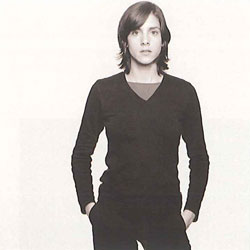Filipa César
Filipa CésarPorto ¶ 1975
 |
|
| Créditos fotográficos / Photographic credits: Abílio Leitão |
She studied at both the Fine Arts Schools of Lisbon and Porto, and she presently lives in Berlin, as she is doing a Master's in Visual Arts at the Hochshule der Kunst, HDK. ¶ César chose video as her main medium at an early stage of her career, focusing on the relationship between inner and outer space by transforming communication strategies into introversion strategies, as well as the other way around. ¶ The relationship themes that are always at the core of her work have led to a series of works in which the flâneur's digress is transformed into a "meeting". A "meeting", that is, with the perspective of the Other, as if one is that Other, who, always and ultimately, peers through the lens, which César simulates as if belonging to someone in particular. It is as if she's staging a persistent romantic ghost of a happenstance encounter, expressing nostalgia through the notions of community and communication. ¶ The most recurrent theme in her work is that of affection's "empty lots", places of the unfeasibility of communication, such as wide urban sidewalks, supermarkets, or waiting rooms. In such places, characters walk past by in an exercise of an alienating combination of aloofness and expectancy, of emptiness and promise. In Romance (2003), the artist combines two halves, which comprise views from a standard attending desk, and creates the illusion that the two people we see are actually dialoguing with each other, generating a "suspension of disbelief" that immediately moves the viewer. ¶ Although generally speaking we will find the author to have a voyeuristic perspective, by utilizing the other people's gaze and by creating the illusion of a relationship between the ones caught by the gaze, one can also find in her work some choices that imply stage directions. In Lull (2002), for example, César stages a waiting room and the customary characters. We can witness an inversion here: instead of simulating a fiction with documentary material, it is a document that is simulated with a fiction piece. ¶ The artist has recently attempted a combination of both affinities. With the goal of producing more complex work in a narrative sense, she gives a meta-fictional use to documentary mechanisms. In F for Fake (2005), one will find an additional layer of imagination over a movie that is already the fictionalisation of a documentary. The author is showing us that in our day and age of electronics there is no within or without in any given mechanism. Rather, to asking us whether, ultimately, the fictionalisation of a documentary of a fiction leads to yet another documentary or a work of fiction.
http://cvc.instituto-camoes.pt/biografias-en/filipa-cesar-88533.html#sigFreeIdb481d2882c


